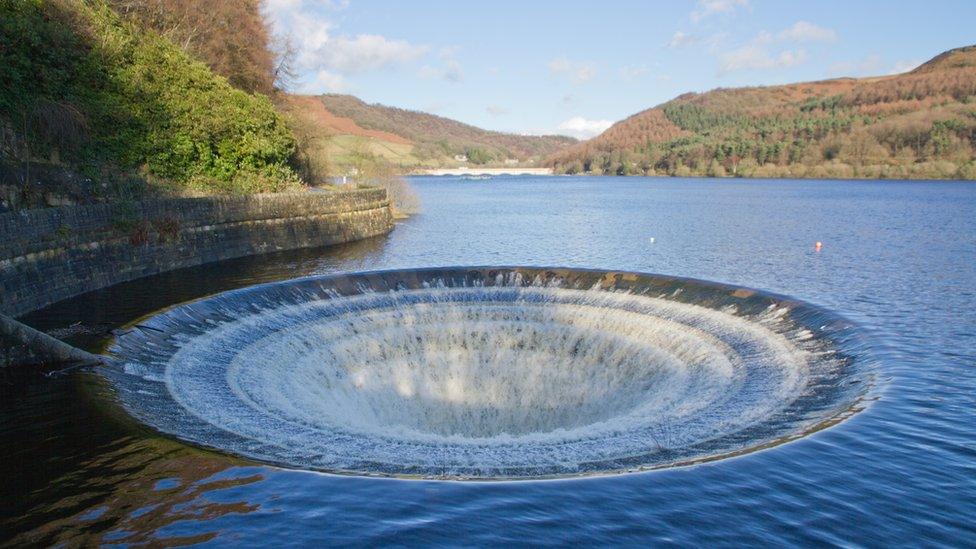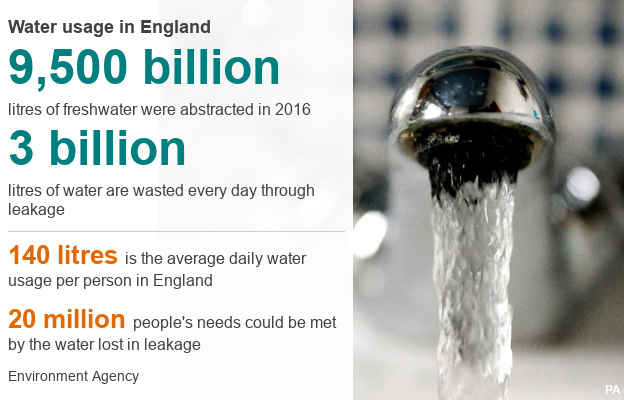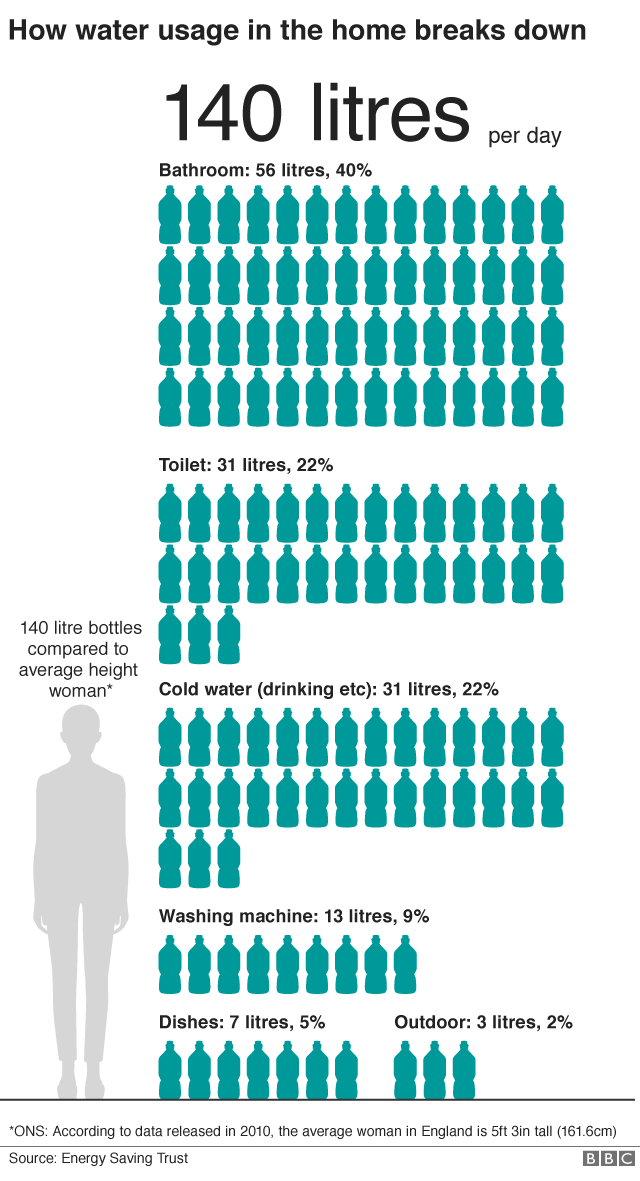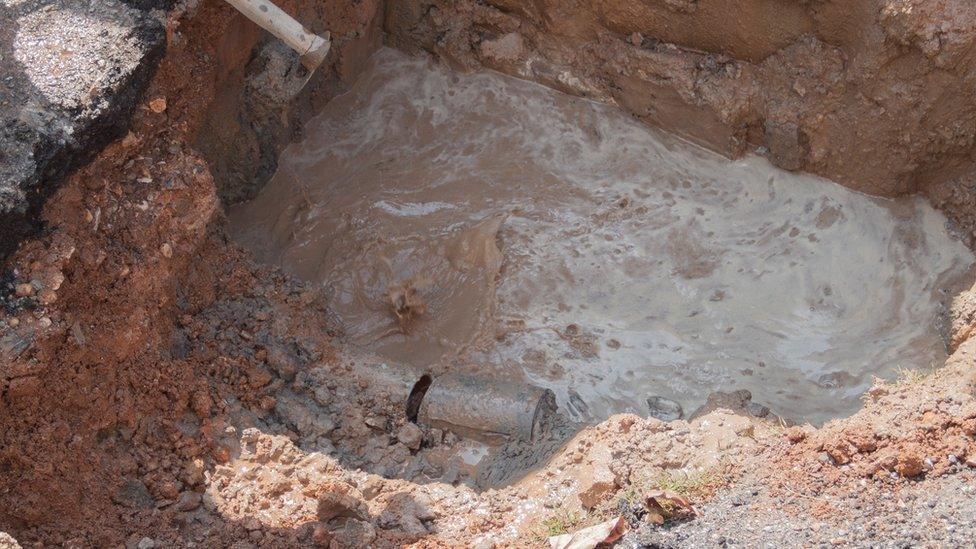Risk of water shortages for England warns Environment Agency
- Published
- comments

Ladybower reservoir in Derbyshire supplies water for drinking and hydro electricity
England is facing water supply shortages by 2050 unless rapid action is taken to curb water use and wastage, the Environment Agency has warned.
Its new report says enough water to meet the needs of 20 million people is lost through leakage every day.
Population growth and the impact of climate change are expected to add to supply pressures.
The agency wants people to have a personal water target and has urged them to use water more wisely at home.
The study, the first major report on water resources in England, external, says that population growth and climate change are the biggest pressures on a system that is already struggling.
In 2016, some 9,500 billion litres of freshwater were taken from rivers, lakes, reservoirs and underground sources, with 55% of this used by public water companies, and 27% going to the electricity supply industry.
But in addition to the 3 billion litres a day that are wasted through leakage, there is a considerable price being paid in terms of the sustainability of these supplies.
According to the Environment Agency, extraction of groundwater - the water beneath the earth's surface - is not at a sustainable level for 28% of groundwater bodies and up to 18% of surface waters.
A year earlier in 2016, unsustainable extraction meant that at least 6% and possibly up to 15% of river water bodies did not achieve "a good ecological status or potential".
The majority of chalk streams also failed to meet that standard, with over extraction of water being responsible in a quarter of the streams that were tested.
"We need to change our attitudes to water use," said Emma Howard Boyd, the Environment Agency chair woman.

"It is the most fundamental thing needed to ensure a healthy environment, but we are taking too much of it and have to work together to manage this precious resource."
Addressing the questions of how to reduce the amount of water that is being used, Michael Roberts, from Water UK, said water companies were tackling the question head-on.
"It's actually everyone's issue," he told the BBC's Victoria Derbyshire programme.
"In the home we have to do our bit and as companies we have to do our bit - but the good news is that domestic consumption has been coming down for the last decade, and in terms of leakage, we are leaking a third less than we did 30 years ago, but there is a heck of a lot more to do."
On average, people use 140 litres every day in England. The Environment Agency says it will work with government and industry to establish a personal consumption target and come up with cost-effective measures to meet it.
The government has already suggested that an individual's water use be reduced, in its 25-year plan, , externalpublished earlier this year.
The water industry says that three quarters of water used in the home goes towards washing ourselves, our clothes and how we flush the toilet. Greater awareness could help cut that amount significantly.
"We'd love to see a really ambitious target of per capita consumption per day," Nicci Russell from Waterwise, who campaign for water efficiency, told the BBC.
"It's around about 140 litres per day and we'd like to see it at 100 or less, we think that's perfectly do-able over the next 20-25 years."


But Environment Minister George Eustice has told BBC Radio 5 live that the proposed Environment Agency household water guidelines are "not a cap" and that "nobody need worry that we're shutting off the taps".
"It's more a target really to encourage individual households to think about their water, to encourage the use of, for instance, flushing systems on toilets that are more economical in the way they use water, and basically get the types of innovation that we need within households over a period of time, so that we are using water more carefully."
The big questions for the future, according to the Environment Agency, are the impacts of climate change and population growth.
Rising temperatures will affect the timing and amount of rainfall that flows into rivers and replenishes groundwater supplies.
Although average summer rainfall is not predicted to change, more rainfall is likely to occur in large downpours in the future, increasing the chances of droughts and floods happening at the same time.
The report warns that reduced summer rain and increased evaporation might damage wetland areas.
Increased areas of stagnant water during droughts coupled with increased temperatures could see the spread of mosquito-borne diseases such as dengue fever and West Nile virus.

Water leaks in England waste three billion litres per day
The population of England is predicted to increase to 58.5 million by 2026 - the report says that much of this increase is likely to take place in areas where water supplies are already stressed.
If no action is taken to reduce use and increase supply of water, "most areas will not meet demand by the 2050s" if both emissions and population growth are high.
Even low population growth and modest climate change "suggest significant water supply deficits by the 2050s, particularly in the South East".
The National Infrastructure Commission has already suggested that moving water from north to south should be considered as part of future development.
"Today's report reflects our own findings, that the country faces the real risk of drought and that we need to take urgent action now to address it - by reducing demand, as well as by increasing supply, said Sir John Armitt, who chairs the commission.
"Our recommendations include the need for a new National Water Network, to help move supplies from areas with water surpluses to those in greatest need.
"But there must be a concerted effort by industry to encourage consumers to use water more efficiently - and with a fifth of our mains water lost to leakages, they must also take steps to halve the amount lost this way by 2050."
Investment in nuclear power and renewable energy will likely lead to much lower rates of abstraction and consumption by 2050, the study says.
However, if future energy scenarios involve carbon capture and storage (CCS), this would require much higher freshwater abstraction and consumption levels, as the technology needs extra water to function, and would also increase the amount of cooling water needed at conventional power plants to which CCS equipment is attached.